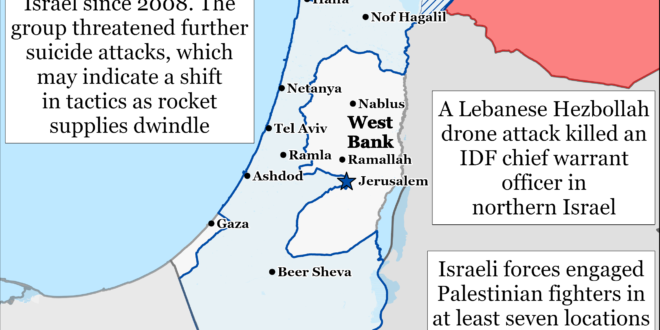The United States, Israel, and international mediators plan to continue ceasefire talks despite Hamas’ rejection of the latest ceasefire-hostage proposal. US Secretary of State Anthony Blinken met with Israeli Prime Minister Benjamin Netanyahu, Israeli President Isaac Herzog, and Israeli Defense Minister Yoav Gallant on August 19 to discuss the ceasefire-hostage deal and the prevention of a regional war.[1] Blinken told reporters before meeting with Israeli President Isaac Herzog that the current ceasefire-hostage talks could be the last chance to achieve a ceasefire.[2] An Israeli official told The Times of Israel that Netanyahu said during the meeting that he will send his top negotiators to this week’s ceasefire summit in Cairo.[3] An anonymous US official said that the Biden administration still expects a resumption of talks from the key negotiating partners later this week.[4] Hamas, however, rejected the ceasefire-hostage proposal produced in the most recent round of talks in Doha and continues to support the July 2024 ceasefire-hostage proposal.[5] Several senior Hamas officials similarly indicated to international media that there are significant obstacles in the ceasefire-hostage negotiations, despite US optimism about the chances of striking a deal.[6]
An unspecified source “familiar with the talks” told a Lebanese news outlet that Egypt agreed not to set a timeline for an Israeli withdrawal from the Philadelphi Corridor during talks in Cairo.[7] An Israeli delegation traveled to Cairo on August 17 to discuss security along the Philadelphi Corridor and opening the Rafah crossing.[8] Al Akhbar reported that Egypt agreed to drop its request for a timeline for Israeli withdrawal from the corridor in return for a reduction of Israeli forces along the border and a complete withdrawal ”as soon as possible.” Egypt also reportedly agreed to ensure there are no operational tunnels leading from Egypt into the Gaza Strip.
Maintaining control over the Philadelphi Corridor by the IDF or another entity capable of preventing smuggling and the operation of tunnels will prevent Hamas and other Palestinian militias from rebuilding their capabilities quickly. Controlling the corridor would very likely make it extremely difficult for Hamas to reconstitute itself to the levels it had achieved prior to October 7 in any short period of time. The IDF has severely degraded elements of Hamas. Israeli military action, though not yet destroying or defeating Hamas, has killed many senior and mid-level Hamas commanders and thousands of fighters.[9] These operations have also destroyed a significant amount of Hamas infrastructure.[10] The IDF assesses that Hamas’ rocket stockpiles are dwindling, and there are increasing indications that Hamas’ governance is breaking down.[11] Hamas police have reportedly “disappeared,” and robbery, looting, and extortion has increased.[12] Hamas reconstitution to the same levels the group achieved prior to October 7 would require the group to undertake large-scale smuggling operations under the Philadelphi Corridor, which will be very difficult with competent border security there.
Iranian officials suggested that Iran will delay its retaliation against Israel for the death of former Hamas head Ismail Haniyeh until after ceasefire negotiations conclude. The United States and international mediators have maintained pressure on Iran to encourage Tehran to delay or indefinitely postpone its attack, arguing that such a delay could help deescalate regional tension. Iranian Ministry of Foreign Affairs Spokesperson Nasser Kanani said that Iran supports the negotiations and it is “waiting to see which direction the negotiations will go and whether America is willing to end this war or not.”[13] Kanani’s comments are likely reflective of Iranian policy towards the negotiations, given that Iran’s acting foreing minister has been responsible for engaging with Qatari mediators during the current round of negotiations.[14] Iranian politician and former Islamic Revolutionary Guard Corps Brigadier General Esmail Kowsari, who has deep personal relationships with top IRGC commanders, claimed that Iran will “respond“ for the death of Haniyeh but argued that ”[Iran] must never rush into carrying out operations that may be very large.”[15] These statements echo statements from other Iranian officials, including Supreme Leader Ali Khamenei. Khamenei maintained that Iran must respond to Israeli attacks targeting senior Axis leaders. Khameni has simultaneously implied that Iran could delay retaliation without compromising its position towards Israel, however.[16]
An unidentified Iraqi militia member claimed that the Axis of Resistance does not “rule out” attacks on targets within Iraq as part of the broader retaliation for the death of Haniyeh.[17] It is unclear whether Iran or a different member of Iran’s Axis of Resistance could conduct the strike in Israel or what the target would be. CTP-ISW assessed on August 2 that Iran and its Axis of Resistance may target US forces in Syria as part of a retaliatory strike for the killing of several Axis of Resistance members, including Haniyeh.[18] Iranian-backed Iraqi militias have conducted attacks targeting US forces in Iraq and Syria as part of their campaign to expel US forces and maintain the capabilities needed to participate in a retaliatory strike on US forces in Iraq.[19] Iran has previously struck targets in the Iraqi Kurdistan Region that Tehran claims are linked to the Mossad or Israel as a whole, however, meaning that Iran could eschew an attack on US forces even if it conducted retaliation within Iraq.
Hamas claimed its first suicide attack in Israel since 2008.[20] Hamas claimed that it conducted a ”martyrdom operation” in southern Tel Aviv on August 18 using an explosive device that killed the attacker and moderately injured one civilian.[21] Hamas said it coordinated the attack with Palestinian Islamic Jihad (PIJ).[22] Israel Police and Shin Bet assessed that the Palestinian suspect was carrying a backpack of explosives that detonated before he reached “a more heavily populated area.”[23] The IDF and Israeli police said that the suspect was a West Bank resident and that the explosive device was “low quality” and likely manufactured in the West Bank.[24] Israeli security forces did not provide further detail on the suspect’s identity. Hamas warned in a statement that suicide bombings in Israel would continue as long as Israel attacks Palestinians, carries out the ”displacement of civilians,” and conducts targeted killings of Palestinian leaders.[25]
Hamas’ threat of further suicide attacks may indicate a shift in tactics as IDF operations destroy Hamas rocket supplies and limit Hamas’ ability to conduct rocket attacks.[26] Hamas uses rocket attacks in part as a way to impose costs on the Israeli civilian population, and it may begin to use other tactics to impose costs on Israeli civilians. Hamas has not claimed a suicide bombing in Israel since 2008 and has not been affiliated with a suicide bombing attack since 2016.[27] Hamas has relied on mortars, rockets, and other systems to conduct regular attacks targeting the Israeli population after it stopped conducting suicide bombings.[28] Current IDF operations are limiting Hamas’ ability to conduct long-range rocket attacks. The IDF has assessed that Hamas’ long-range rocket and launcher supply is dwindling, and its forces frequently destroy rocket stockpiles on the ground.[29] The IDF Air Force also responds rapidly to rocket launches, quickly destroying relatively rudimentary launch sites from which Hamas has launched rockets into Israel.[30] Hamas retains a very limited ability to continue rocket attacks targeting major Israeli population centers such as Tel Aviv. The group attempted to fire two rockets at Tel Aviv on August 13, but the last Hamas rocket attack targeting Tel Aviv prior to August 13 came on May 26.[31] This demonstrates that Hamas may attempt to revert to suicide attacks to target Israeli civilian centers, though its ability to do so successfully will be hampered by far more effective Israeli preventative measures that did not exist in the 1990s and 2000s.[32]
Iranian ministerial nominees outlined their agendas to Parliament on August 18 and 19.[33] The nominees’ proposed policies are largely consistent with current regime policies. Parliament will vote to approve nominees on August 21 or 22.[34] Below are the agendas of several prominent ministerial nominees:
Abbas Araghchi (Foreign Affairs Minister): Araghchi echoed Supreme Leader Ali Khamenei’s foreign and nuclear policies. Araghchi stated that he would seek to both “neutralize” and “lift” Western sanctions on Iran.[35] Lifting sanctions refers to pursuing nuclear negotiations with the West, while neutralizing sanctions refers to mitigating the impact of sanctions by promoting self-sufficiency and bilateral relationships with regional and extra-regional countries. Araghchi stated that Iran will neither rush to enter negotiations nor “fall into the trap of erosive negotiations.”[36] Araghchi’s statements mirror recent remarks by Khamenei about nuclear negotiations.[37] Araghchi also stated that he would prioritize developing relations with China, Russia, and other countries that stood by Iran “during times of hardship and [helped Iran evade] sanctions.”[38] Araghchi added that Iran could choose to improve ties with European countries if “Europe amends its wrong and hostile behavior” toward Iran. Khamenei similarly stated on July 28 that Iran could choose to mend its relations with European countries if these countries stop their “bad behavior.”[39] Araghchi conversely stated that he will pursue a policy of “conflict management” with the United States.[40] Araghchi lastly stated that he seeks to be a “hardworking and active” foreign affairs minister like his predecessor, Hossein Amir Abdollahian.
Brigadier General Aziz Nasir Zadeh (Defense and Armed Forces Logistics Minister): Nasir Zadeh emphasized the importance of “active deterrence” to prevent foreign attacks on Iran.[41] Iran’s active deterrence doctrine involves building strategic depth and regional influence to establish control over the operational environment, which in turn facilitates taking the initiative when necessary to suppress any nascent threat from endangering the homeland.[42] Nasir Zadeh claimed that Iran’s April 13 drone and missile attack on Israel decreased Israel’s ability to deter Iran, causing the United States to try to ”strengthen…Israel’s deterrence.” Nasir Zadeh also stated that he would try to increase Iran’s production of advanced military equipment and military exports to “friendly countries.”[43] The Iranian defense minister is primarily responsible for managing arms procurement and sales and the Iranian defense industrial base.[44]
Esmail Khatib (Intelligence and Security Minister): Khatib stated that he would work to strengthen border and cyber security, confront the West’s “cognitive warfare” against Iran, and promote “stable security” as intelligence minister.[45] Khatib has served as Iran’s intelligence minister since 2021.
Abdul Naser Hemmati (Economic Affairs and Finance Minister): Hemmati emphasized the need to reduce inflation and stabilize the Iranian economy, attract foreign investment, and fully implement pre-existing economic policies.[46] Hemmati previously served as the Central Bank of Iran governor under former President Hassan Rouhani between 2018 and 2021.[47]
Key Takeaways:
- Iranian Retaliation and Ceasefire Negotiations: The United States, Israel, and international mediators plan to continue ceasefire talks despite Hamas’ rejection of the latest ceasefire-hostage proposal. Iranian officials suggested that Iran will delay its retaliation against Israel for the death of former Hamas head Ismail Haniyeh until after ceasefire negotiations conclude.
- Gaza Strip: An unspecified source “familiar with the [ceasefire] talks” told a Lebanese news outlet that Egypt agreed not to set a timeline for an Israeli withdrawal from the Philadelphi Corridor during talks in Cairo. Control over the Philadelphi Corridor by the IDF or another entity capable of preventing smuggling and the operation of tunnels will prevent Hamas and other Palestinian militias from rebuilding their capabilities quickly. Controlling the corridor would very likely make it extremely difficult for Hamas to reconstitute itself to the levels it had achieved prior to October 7 in any short period of time.
- Terror Attack in Tel Aviv: Hamas claimed its first suicide attack in Israel since 2008. Hamas threatened further suicide attacks, which may indicate a shift in tactics as IDF operations destroy Hamas rocket supplies and limit Hamas’ ability to conduct rocket attacks.
- Iranian Presidential Cabinet Formation: Iranian ministerial nominees outlined their agendas to Parliament on August 18 and 19. The nominees’ proposed policies are largely consistent with current regime policies.

Gaza Strip
Axis of Resistance objectives:
Erode the will of the Israeli political establishment and public to sustain clearing operations in the Gaza Strip
Reestablish Hamas as the governing authority in the Gaza Strip
Hamas fighters conducted a complex attack that killed two IDF soldiers in Zaytoun, south of Gaza City, on August 17.[48] Geolocated footage showed four fighters planting two improvised explosive devices along a road in southern Zaytoun.[49] The fighters detonated the explosives as an IDF logistics convoy passed, and then the fighters exited a nearby building and fired small arms at the IDF convoy.[50] Israeli Army Radio reported that the IDF logistics convoy entered the outskirts of Zaytoun neighborhood to deliver resources to Israeli forces operating in Zaytoun.[51] Hamas killed two soldiers in the 16th Infantry Brigade (Res.) in the attack.[52]
The al Aqsa Martyrs’ Brigades and the Ansar Brigades—the military wing of the Palestinian Freedom Movement—mortared Israeli forces near the University College of Applied Sciences in Tal al Hawa, south of Gaza City, on August 19.[53] A Palestinian journalist reported IDF armor present in the area.[54]
The IDF 252nd Division continued to operate around the Netzarim Corridor on August 19.[55] Israeli forces directed an airstrike targeting two Hamas fighters in a “hideout.”[56] Israeli forces also directed an airstrike targeting a Hamas headquarters in an unspecified location near the corridor.[57] Palestinian sources reported that IDF armor advanced slightly further south of the Wadi Gaza Bridge on August 19.[58]
The IDF 98th Division continued clearing operations in Khan Younis on August 19. The IDF 7th Brigade further expanded operations into northern Khan Younis and the outskirts of Deir al Balah on August 19.[59] Israeli forces killed Palestinian fighters and destroyed militia facilities above and below ground in the area. Israeli combat engineers located and destroyed an underground tunnel northeast of al Qarara that extends one and a half kilometers west into the Gaza Strip.[60] Israeli forces located a Hamas compound along the tunnel that contained explosives, unspecified weapons, and indications that fighters had used the facility for extended periods of time.[61] The IDF said that Hamas fighters fled the compound as Israeli forces approached the area.[62] The combat engineers also separately located a militia compound that contained dozens of rockets, launchers, and several anti-tank missiles.[63]
A Palestinian journalist reported that IDF armor and aircraft operated in Hamad and Asdaa, northwest Khan Younis, on August 19.[64] The IDF reported that the IDF 35th Paratroopers Brigade expanded clearing operations in western Khan Younis on August 18 and advanced into Hamad neighborhood.[65] The IDF removed a section of northwest Khan Younis including Hamad and Asdaa from the al Mawasi humanitarian zone on August 16 prior to entering the area.[66] The Palestinian journalist reported IDF vehicle fire and artillery shelling in Asdaa and Hamad that injured several civilians.[67]
The 98th Division directed airstrikes targeting a Hamas fighter who the IDF said fired projectiles towards Ein HaShlosha on August 18.[68] The IDF reported that Hamas launched rockets into Israeli territory on August 18 from a site located near civilian infrastructure in southern Khan Younis.[69] The IDF said that Hamas regularly exploits civilian structures to conduct attacks against Israel.[70]
The IDF 162nd Division continued to operate in Rafah on August 19.[71] Israeli forces killed dozens of fighters, located weapons, and destroyed militia infrastructure above and below ground in Tal al Sultan.[72] A Palestinian fighter fired an anti-tank guided missiles targeting Israeli forces on August 18.[73] Israeli forces directed an airstrike against the fighter.[74] Hamas fired rocket-propelled grenades targeting Israeli armor and a tandem-charged RPG targeting an Israeli armored personnel carrier in Badr Camp, Tal al Sultan.[75]
The IDF Air Force struck over 45 militia targets in the Gaza Strip since CTP-ISW’s last data cut off on August 17.[76]
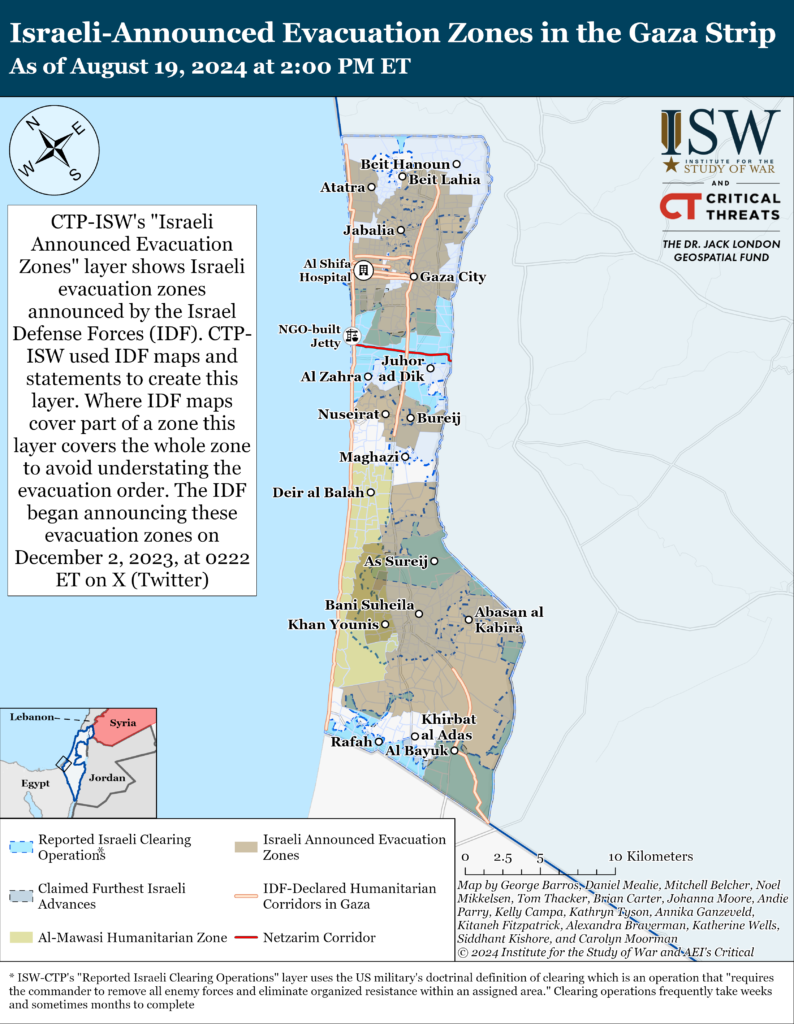
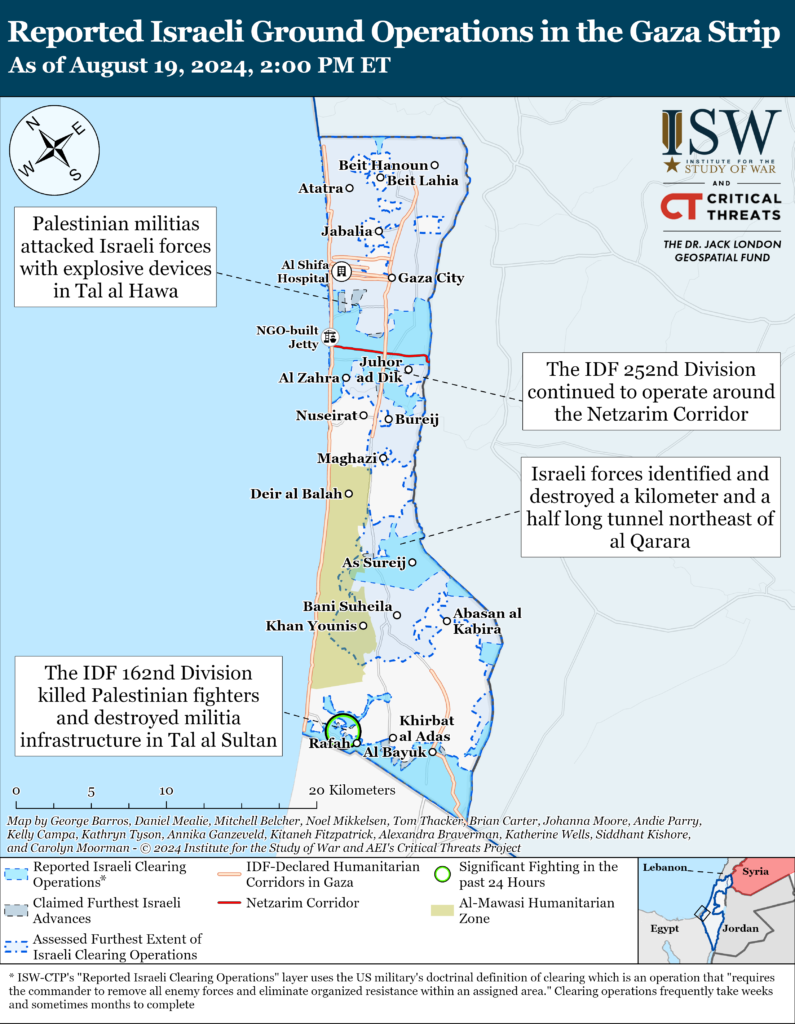
The Popular Front for the Liberation of Palestine fired rockets targeting an IDF site in southern Israel on August 18.[77]
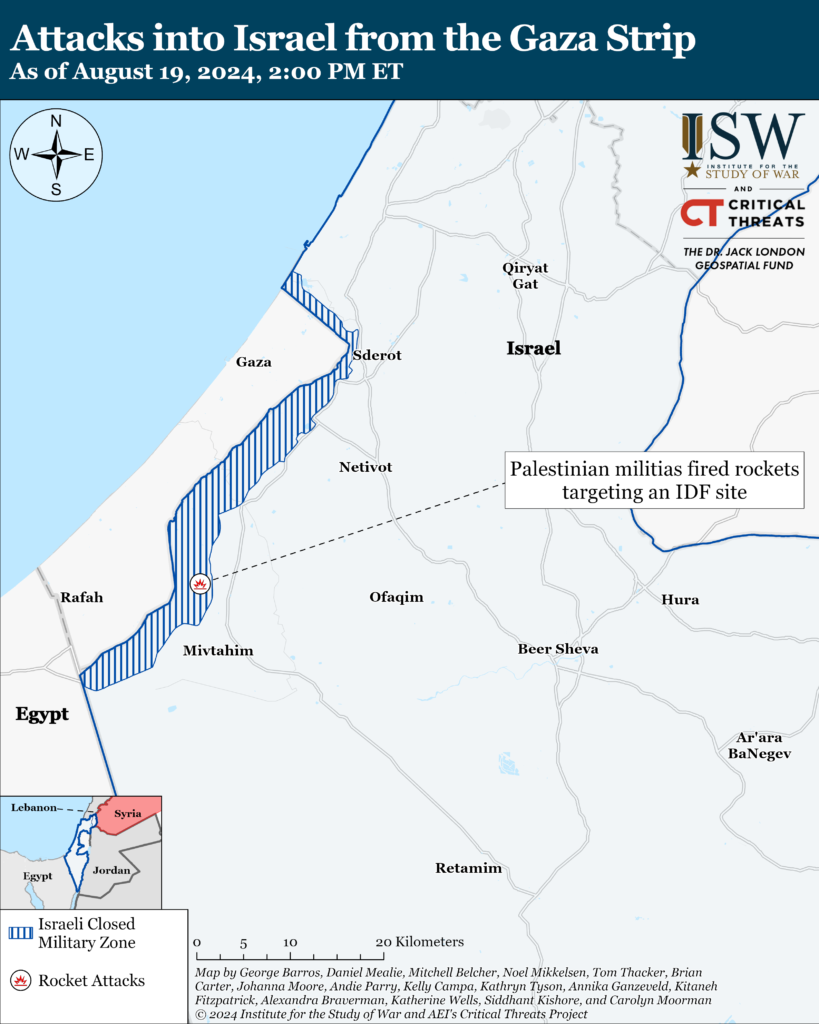
Recorded reports of attacks; CTP-ISW cannot independently verify impact.
West Bank
Axis of Resistance objectives:
Establish the West Bank as a viable front against Israel
Israeli forces have engaged Palestinian fighters in at least seven locations in the West Bank since CTP-ISW’s last data cutoff on August 18.[78] The al Aqsa Martyrs’ Brigades fired small arms and detonated improvised explosive devices (IED) targeting Israeli forces in Nablus.[79]
Israeli forces are attempting to locate the attacker responsible for killing an Israeli security guard in the Kedumim settlement, east of Qalqilya, on August 18.[80] Israeli forces established roadblocks in the area of the attack, seized the attacker‘s car, and demolished the attacker’s home.[81]
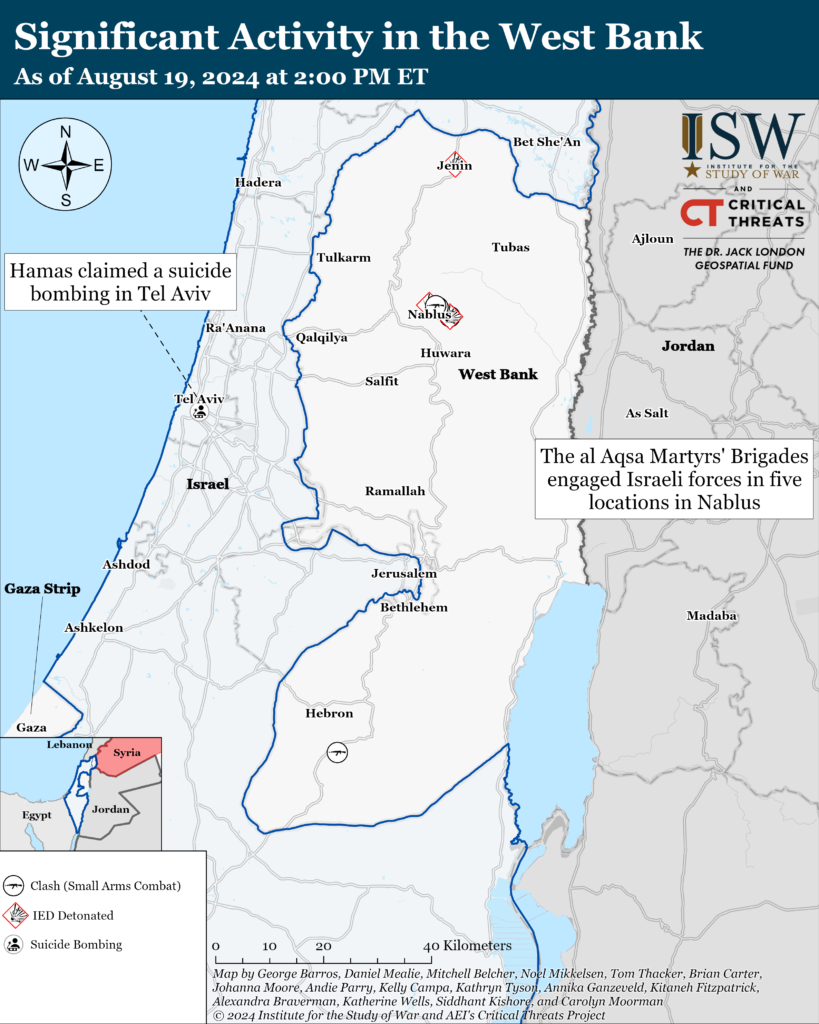
This map is not an exhaustive depiction of clashes and demonstrations in the West Bank.
Southern Lebanon and Golan Heights
Axis of Resistance objectives:
Deter Israel from conducting a ground operation into Lebanon
Prepare for an expanded and protracted conflict with Israel in the near term
Expel the United States from Syria
Lebanese Hezbollah has conducted at least 13 attacks into northern Israel since CTP-ISW’s last data cutoff on August 18.[82] The IDF intercepted three Hezbollah drones over northern Israel.[83] Two Hezbollah drones struck Gesher HaZiv and near Ya’ra, killing an IDF warrant officer from the IDF 300th Regional Brigade and injuring several other IDF soldiers in Ya’ra.
The IDF Air Force conducted airstrikes targeting a Hezbollah weapons depot near Nabi Chit, Baalbek District, Lebanon, on August 19.[84]
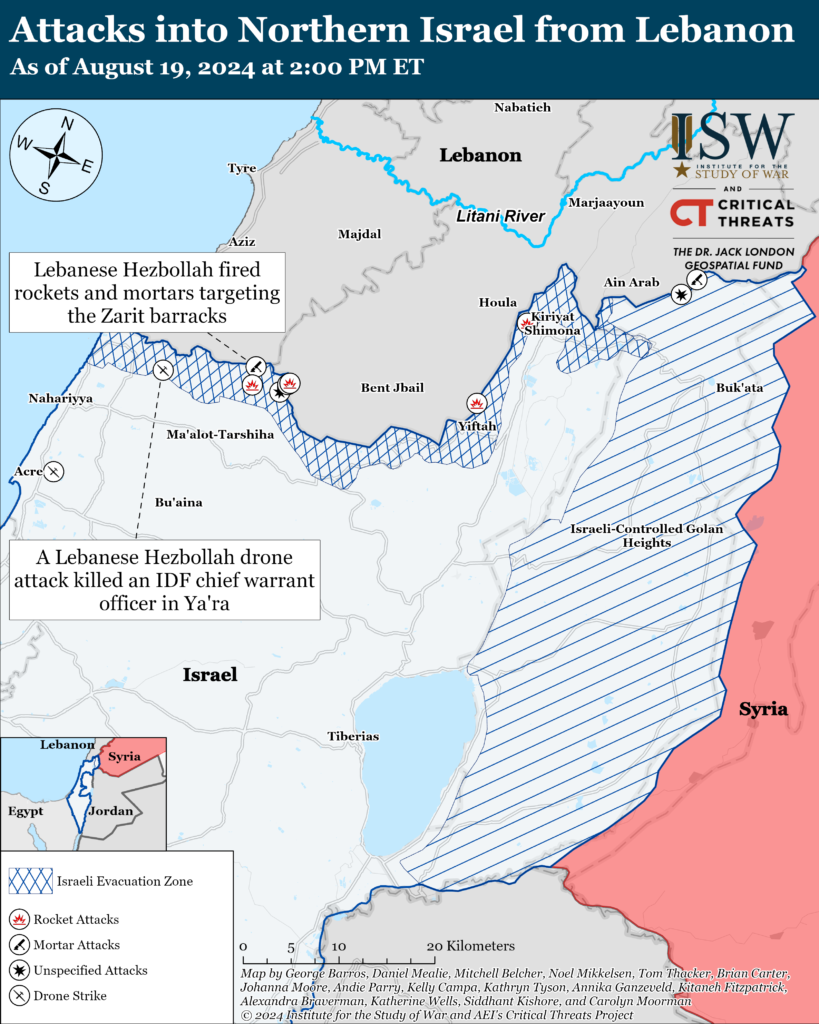
Iran and Axis of Resistance
The Islamic Resistance in Iraq—a coalition of Iranian-backed Iraqi militias—claimed on August 18 that it conducted a drone attack targeting a “military target” in the Israeli-controlled Golan Heights sometime between August 11 and August 18.[85] This is the first attack the Islamic Resistance of Iraq has claimed since July 23.[86]
Iranian media reported on August 17 that President Masoud Pezeshkian has retained Mohammad Javad Zarif as an adviser in his government.[87] Zarif resigned on August 11 after Pezeshkian appointed Zarif as vice president for strategic affairs. Zarif reportedly resigned because he opposed the composition of Pezeshkian’s cabinet nominees.[88]
Turkish Ambassador to Iran Hicabi Kirlangic discussed Turkish-Iranian relations and Turkey’s views on regional conflicts with an Islamic Revolutionary Guards Corps (IRGC)-affiliated media outlet on August 19.[89] Kirlangic discussed Turkish-Iranian cultural and diplomatic ties, describing the ties as generally positive despite occasional tension. Kirlangic noted that although trade volume has decreased, the economic relationship between Iran and Turkey remains strong. Kirlangic addressed the dilemma of Syria by underlining that Turkey supports Syria’s territorial integrity but remains concerned about terrorism in northern Syria. Kirlangic emphasized the need for Iran to play a constructive role in Syria-Turkey normalization. Kirlangic noted that Turkey remains concerned about the US presence in Syria and said that Iran and Turkey play an important role in stabilizing the region. Kirlangic added that the Erdogan government does not want to harm the interests of Armenia, Azerbaijan, and Iran by destabilizing the Caucasus. He added that Turkey seeks a resolution to the Zangezur Corridor. The Iranian regime has historically opposed Azerbaijani and Turkish efforts to establish the Zangezur corridor between Azerbaijan proper and the Nakhchivan Autonomous Republic because such a corridor would sever Iran’s land access to Russia and Europe via Armenia.[90]
Iran displayed the B1 one-way attack drone for the first time at Russia’s ARMY 2024 exhibition on August 12 to 14, which has a 25-minute flight time, 12 kilometers (7.46 miles) range, and the ability to carry 2kg warhead.[91] Iran also showcased the H5 reconnaissance quadcopter, synthetic aperture radars (SAR) with 40 km (about 24.85 mi) and 150 km (about 93.21 mi) ranges, and the Shahed 129 drone.[92] Iran’s delegation exhibited various cruise missiles, the Arman tactical rocket launcher, upgraded Zelzal rockets, Almas anti-tank missiles, Balaban guided bombs, and Khordad-3 air defense system replicas. Iran also unveiled the Mohajer-10 reconnaissance and combat drone, which has a 7,000m service ceiling and 2,000 km (about 1242.74 mi) range and a payload of 300 kilograms.[93] The Mohajer-10 can also carry smart ammunition, such as Almas anti-tank missiles or Qaem smart glider bombs.[94]
US Central Command (CENTCOM) successfully destroyed a Houthi drone over Houthi controlled territory in Yemen on August 18.[95] CENTCOM determined that the Houthi drone presented a clear and imminent threat to US and coalition forces and merchant vessels in the region.
 Eurasia Press & News
Eurasia Press & News
